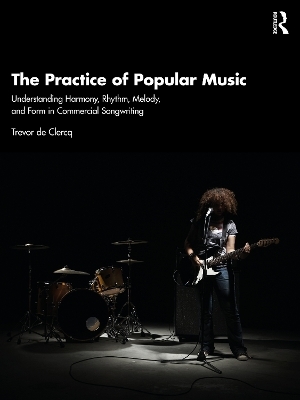
The Practice of Popular Music
Routledge (Verlag)
978-1-032-36289-2 (ISBN)
Beginning with fundamentals and requiring no previous training in music theory or notation, this book eventually guides the reader through a range of advanced topics, including chromatic mixture, secondary chord function, complex time signatures, and phrase organization. Each chapter develops concepts in tandem with aural comprehension, and the included exercises balance written tasks with listening activities. A companion website provides links to playlists of the music discussed in the book.
With an innovative approach designed to broaden the reach of music theory coursework to a wide range of students, including non-majors and those in modern music degree programs such as audio engineering, songwriting, and music business, this textbook enables readers to gain a deep understanding of music theory in the context of popular music.
Trevor de Clercq is a Professor in the Department of Recording Industry at Middle Tennessee State University.
1. Musical Domains
1.1 The Rhythm Domain
1.2 The Pitch Domain
1.3 Song Form
1.4 Other Domains
2. Major Frameworks
2.1 Major Scales
2.2 Small Intervals
2.3 Beat Divisions
2.4 Transitions in Form
2.5 Key Signatures
3. Essential Structures
3.1 Perfect Intervals
3.2 Syncopation
3.3 Triads
3.4 Harmonic Rhythm
3.5 Triads in a Key
4. Context Matters
4.1 Chord Progressions in Major Keys
4.2 Melodic Organization
4.3 Drum Feels in 4/4
4.4 Triple Divisions
5. Alternative Frameworks
5.1 Compound Meter
5.2 Shuffle and Swing
5.3 Relative Minor Keys
5.4 Chord Progressions in Minor Keys
6. Relevant Connections
6.1 Supertonic and Mediant
6.2 Triple Meters
6.3 Melodic Embellishments
7. Expanded Elements
7.1 Sixteenth Notes
7.2 Larger Intervals
7.3 Seventh Chords
8. Core Endings
8.1 Formal Suffixes
8.2 Swung Sixteenth Notes
8.3 Chord Inversion
9. New Perspectives
9.1 Parallel Minor Keys
9.2 Syncopated Sixteenth Notes
9.3 Phrase Organizations
10. Missing Pieces
10.1 Partial Bars and Hyperbars
10.2 Atonic Tonics
10.3 AABA form
11. Colorful Combinations
11.1 The Blues
11.2 Harmonic Mixture
11.3 Cross Rhythms
12. Additions and Deletions
12.1 Add and Sus Chords
12.2 Modes
12.3 Quintuple Meters
13. Level Explorations
13.1 Secondary Dominants
13.2 Half-time and Double-time Outside 4/4
13.3 Syncopated Sixteenth Notes in 6/8
14. Further Extensions
14.1 Harmonic-Bass Divorce
14.2 Extended Chords
14.3 Other Applied Chords
14.4 Septuple Meters
15. Some Substitutions
15.1 Inverted Secondary Dominants
15.2 Diminished Seventh Chords
15.3 Tritone Substitutions
16. Significant Shifts
16.1 Tonal Modulation Strategies
16.2 Metric Modulation
| Erscheinungsdatum | 22.08.2024 |
|---|---|
| Zusatzinfo | 434 Line drawings, black and white; 434 Illustrations, black and white |
| Verlagsort | London |
| Sprache | englisch |
| Maße | 210 x 280 mm |
| Gewicht | 910 g |
| Themenwelt | Kunst / Musik / Theater ► Musik ► Musiktheorie / Musiklehre |
| Kunst / Musik / Theater ► Musik ► Pop / Rock | |
| ISBN-10 | 1-032-36289-8 / 1032362898 |
| ISBN-13 | 978-1-032-36289-2 / 9781032362892 |
| Zustand | Neuware |
| Informationen gemäß Produktsicherheitsverordnung (GPSR) | |
| Haben Sie eine Frage zum Produkt? |
aus dem Bereich


